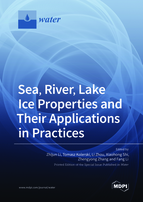Sea, River, Lake Ice Properties and Their Applications in Practices
A special issue of Water (ISSN 2073-4441). This special issue belongs to the section "New Sensors, New Technologies and Machine Learning in Water Sciences".
Deadline for manuscript submissions: closed (31 January 2023) | Viewed by 31845
Special Issue Editors
Interests: ice physical and mechanical properties; ice engineering; polar sciences and technology; ecosystem under ice; physical modeling
Special Issues, Collections and Topics in MDPI journals
Interests: mathematical modeling; river ice; ice load; hydrological modeling; river hydraulics
Special Issues, Collections and Topics in MDPI journals
Interests: ploar ship; ice-structure interaction; ice load; ice navigation; ice management; ice model test; numerical modelling; ice resistance; propeller
Special Issues, Collections and Topics in MDPI journals
Interests: ice environment of rivers and lakes; mechanism of environmental evolution; hydrologic process; pollutant transfer; water environment protection and restoration
Interests: glacier change; hydro-ecology; mass balance; climate change; environmental evolution
Interests: ice mechanics; ice-structure interaction; ice loads; ice navigation; ship performance in ice
Special Issues, Collections and Topics in MDPI journals
Special Issue Information
Dear Colleagues,
The ice texture properties significantly depend on crystal variants and connection style between crystal boundaries. The connection style is sensitive to the temperature surrounding the ice material. With global warming, the increase of ice temperature at high-latitude areas is observed and it is expected that the process will accelerate in the future. The ice research advances for the cold regions at the middle latitude, where the ice temperature is near freezing point may support the ice sciences and engineering at polar regions. Therefore, understanding the properties of sea, river, and lake ice, especially the ice properties near the freezing point, and their applications in different practices are useful for polar ice science and engineering.
This special issue will cover the physical, thermal, mechanical, optical, and electrical properties of any kind of crystal ice and ice sheet. The scope will also include remote sensing, engineering, ecosystem, and entertainment by multi approaches of tests, theoretical analysis, numerical modeling, and physical modeling. The other topics closely related to this issue are also welcome.
The special issue is prepared to address the “higher temperature” ice properties and their applications. The issue can guide future ice science and engineering in polar regions under climate change.
Prof. Dr. Zhijun Li
Dr. Tomasz Kolerski
Prof. Dr. Li Zhou
Prof. Dr. Xiaohong Shi
Prof. Dr. Zhengyong Zhang
Dr. Fang Li
Guest Editors
Manuscript Submission Information
Manuscripts should be submitted online at www.mdpi.com by registering and logging in to this website. Once you are registered, click here to go to the submission form. Manuscripts can be submitted until the deadline. All submissions that pass pre-check are peer-reviewed. Accepted papers will be published continuously in the journal (as soon as accepted) and will be listed together on the special issue website. Research articles, review articles as well as short communications are invited. For planned papers, a title and short abstract (about 100 words) can be sent to the Editorial Office for announcement on this website.
Submitted manuscripts should not have been published previously, nor be under consideration for publication elsewhere (except conference proceedings papers). All manuscripts are thoroughly refereed through a single-blind peer-review process. A guide for authors and other relevant information for submission of manuscripts is available on the Instructions for Authors page. Water is an international peer-reviewed open access semimonthly journal published by MDPI.
Please visit the Instructions for Authors page before submitting a manuscript. The Article Processing Charge (APC) for publication in this open access journal is 2600 CHF (Swiss Francs). Submitted papers should be well formatted and use good English. Authors may use MDPI's English editing service prior to publication or during author revisions.
Keywords
- ice crystals
- ice structure
- ice properties
- remote sensing
- engineering
- ecosystem
- observations and investigations
- numerical modeling
- physical modeling











